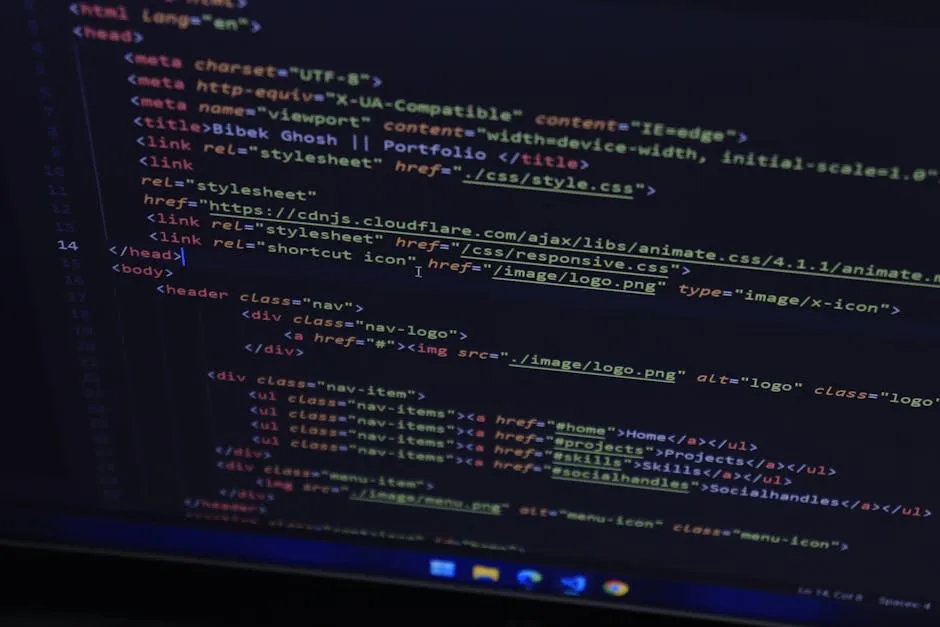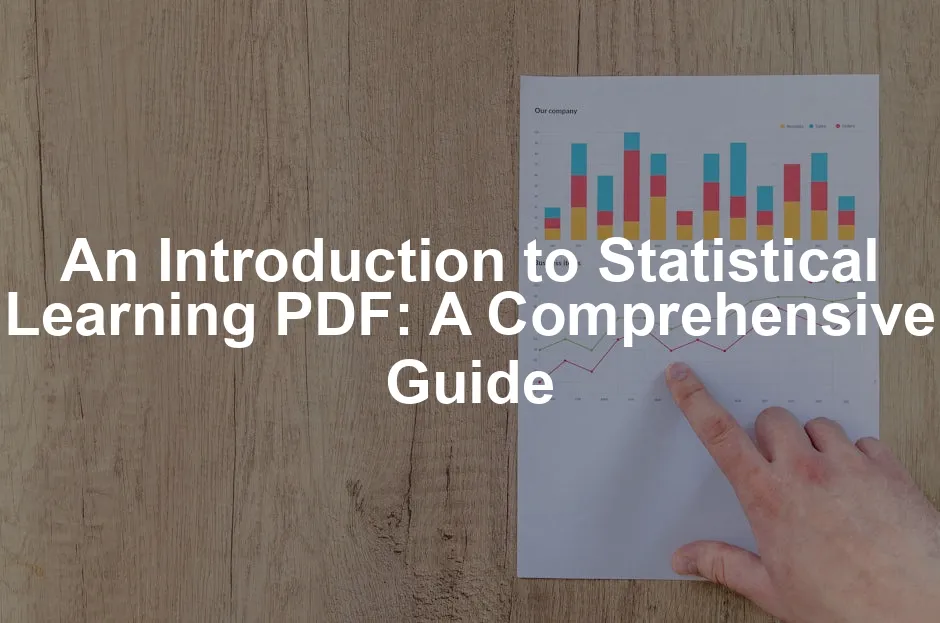Introduction
In an age where data rules, statistical learning emerges as a superhero. With the exponential growth of data collection across various fields, understanding this treasure trove of information has never been more critical. From healthcare to finance, businesses utilize statistical learning to derive insights and make informed decisions. But what exactly is statistical learning?

Enter the book “An Introduction to Statistical Learning” (ISLR). This gem aims to make statistical learning accessible to everyone—whether you’re a data novice or a seasoned analyst. Written by renowned authors Gareth James, Daniela Witten, Trevor Hastie, and Robert Tibshirani, the book provides a user-friendly introduction to the concepts and techniques used in statistical learning. It breaks down complex topics into digestible nuggets, making it perfect for those who might find traditional textbooks a bit intimidating.
And guess what? The ISLR is available in multiple formats, including a PDF version! So, whether you prefer to scroll on your tablet or flip through the pages of a hardcover, there’s an option for you. With the PDF being freely accessible, you can dive into the world of statistical learning without breaking the bank!
This article will cover key topics from the book, including the authors’ backgrounds, the different editions available, and what you can expect to learn. We will explore not just the insights contained in the PDF but also the practical applications that make statistical learning essential in today’s data-driven landscape. Get ready to unlock the mysteries of statistical learning and discover how it can transform your approach to data analysis.
Statistical learning is a crucial skill in today’s data-driven world. To learn more about the book that introduces these concepts, check out an introduction to statistical learning with python book length.
As we dive deeper, expect to encounter real-life examples, practical exercises, and a friendly, engaging tone that makes the complex seem simpler. So grab your digital copy, and let’s embark on this enlightening journey through the world of statistical learning!
Overview of “An Introduction to Statistical Learning”
Publication Information
“An Introduction to Statistical Learning” (ISLR) has seen multiple editions, each enhancing its value for readers. The first edition, released in 2013, set the stage for many budding statisticians. Then came the second edition in 2021, which introduced new topics like deep learning and survival analysis. Fast forward to 2023, and the Python edition made its debut, catering to the growing demand for Python-based applications in statistical learning.

Translations? Oh, they’ve got you covered! The book is available in several languages, including Chinese, Italian, Japanese, Korean, Mongolian, Russian, and Vietnamese. This broad range ensures that non-English speakers can also access the wealth of knowledge packed into these pages.
Each edition includes a lab at the end of every chapter, allowing readers to practically apply the concepts learned in either R or Python. This hands-on approach not only reinforces understanding but also equips readers with essential skills for real-world applications. If you’re looking to kickstart your Python journey, consider grabbing a copy of Python for Data Analysis, a fantastic resource that complements ISLR perfectly!
Authors and Their Contributions
The powerhouse team behind ISLR includes Gareth James, Daniela Witten, Trevor Hastie, Robert Tibshirani, and Jonathan Taylor. Each author brings a unique flavor to the table:
- Gareth James: Currently serving as the John H. Harland Dean at Emory University’s Goizueta Business School, he has made significant contributions to statistical methodology and data science education.
- Daniela Witten: A Professor of Statistics and Biostatistics at the University of Washington, she focuses on statistical machine learning techniques, especially for complex data analysis. Her work has helped bridge the gap between theory and practical application.
- Trevor Hastie: As a Professor at Stanford University, he co-authored the well-known book The Elements of Statistical Learning. His work has shaped the landscape of statistical modeling and machine learning.
- Robert Tibshirani: Also from Stanford, he is known for creating the lasso method, a key technique in regression analysis. His expertise lies in statistical learning and its applications in biomedical data science.
- Jonathan Taylor: The newest addition to the team, he specializes in selective inference and high-dimensional data analysis. His insights have helped modernize the content in the latest editions.
Together, these authors have contributed extensively to the field, making significant strides in statistical learning and data analysis methodologies. If you’re curious about how authors leverage statistical methods in their writing, you can read more about it here.

Structure of the Book
The structure of ISLR is meticulously designed to guide readers through the intricate world of statistical learning. Here’s a sneak peek at some key topics covered in the book:
- Statistical Learning: An introduction to the fundamental concepts that underpin statistical learning, helping readers understand the landscape.
- Regression: This chapter dives into simple and multiple linear regression, exploring the art of predicting outcomes based on predictor variables.
- Classification: Readers learn about various classification techniques like logistic regression, linear discriminant analysis (LDA), and naive Bayes. It’s a rollercoaster of decision-making!
- Resampling Methods: This section covers techniques like cross-validation and bootstrapping, vital for assessing model performance.
- Model Selection and Regularization: The book introduces shrinkage methods, including Lasso and Ridge regression. These are crucial for managing high-dimensional data.
- Advanced Topics: The latter chapters touch on deep learning, survival analysis, and unsupervised learning, providing a holistic view of the field.

Each chapter is crafted with care, incorporating labs and exercises that reinforce learning and encourage hands-on practice. Whether you’re a beginner or a seasoned data enthusiast, ISLR provides a comprehensive and engaging journey through statistical learning. With its witty tone and practical insights, it’s a book that’s hard to put down!
Practical Applications and Labs
Hands-On Learning
When it comes to grasping statistical learning, nothing beats getting your hands dirty! Practical applications are the backbone of understanding complex concepts. They transform abstract theories into real-world solutions. That’s where the labs included in “An Introduction to Statistical Learning” come into play, providing a practical framework.

Each chapter of the book features a lab that allows readers to apply newly learned concepts. This hands-on approach fosters deeper understanding and retention. Want to know what you’ll be working with? Here are some examples of the datasets featured in the labs:
- Wage Data: This dataset explores the relationship between wages and various demographic factors. It examines how variables such as age, education, and experience influence income. By analyzing this data, you can uncover patterns that could inform economic policies or individual career choices.
- Stock Market Data: This dataset focuses on predicting movements in the S&P 500 stock index. Using past percentage changes, you’ll experiment with different statistical models to forecast whether the index will rise or fall. It’s like playing the market without the risk!
- Gene Expression Data: This dataset, known as NCI60, contains gene expression measurements for cancer cell lines. By clustering these cell lines based on their characteristics, you can gain insights into the underlying biology. Who knew data could have such a profound impact on healthcare?
These labs not only reinforce the book’s theoretical concepts but also prepare you for real-world applications. You’ll be able to tackle actual data challenges with confidence. And with a touch of humor, you might find yourself saying, “I’m a statistician, but I also play with data!”

Software and Tools
To implement statistical learning techniques effectively, R and Python reign supreme! They are the dynamic duo every data enthusiast needs in their toolkit. Both languages offer robust libraries that make statistical analysis a breeze.
R: A favorite among statisticians, R provides packages tailored for statistical learning. From linear regression to advanced machine learning techniques, R has it all. Its user-friendly syntax allows for quick implementation, making it a go-to for those who love to analyze data.
Python: On the other hand, Python is the Swiss army knife of programming languages. With libraries like Hands-On Machine Learning with Scikit-Learn, Keras, and TensorFlow, Python expands your toolkit beyond traditional statistics. Whether you’re diving into deep learning or tackling complex data structures, Python’s versatility is unmatched.
The book also provides resources to help you practice these languages. You’ll find examples, code snippets, and exercises that allow you to test your skills. By the end of your reading, you’ll be able to strut into the data science world with all the confidence of a seasoned pro.

In summary, the practical applications and tools highlighted in “An Introduction to Statistical Learning” ensure that you’re not just learning theory. You’re gearing up to make a real impact in the data-driven landscape of today. So, roll up your sleeves, grab your laptop, and let’s make some statistical magic happen!
FAQs
What is the main focus of “An Introduction to Statistical Learning”?
“An Introduction to Statistical Learning” primarily focuses on providing foundational knowledge in statistical learning. The book covers key topics such as regression, classification, and resampling methods. It serves as a guide for those looking to understand how to analyze data effectively and implement modern statistical techniques.
Are there any prerequisites for understanding the content of the book?
While the book is designed to be accessible, a basic understanding of statistics and some familiarity with programming (especially in R or Python) will be beneficial. However, the authors explain concepts clearly, making it possible for beginners to grasp the material without extensive background knowledge.
Can I use the book for self-study?
Absolutely! The structure of the book, with its clear explanations and practical labs, makes it ideal for self-study. Each chapter builds on previous concepts, allowing you to learn progressively. The exercises and labs provide hands-on experience, making self-learning engaging and effective.
What programming languages are covered in the book?
The book predominantly focuses on R and also includes a Python edition. Readers can choose the version that best suits their preference. Both languages are used to demonstrate statistical learning techniques, ensuring that you can apply what you learn using your preferred programming tools.
Where can I find additional resources for learning statistical learning concepts?
In addition to the book, various online resources are available. Websites like the book’s official page offer free PDFs, additional exercises, and datasets for practice. Online courses, forums, and communities such as Stack Overflow or Reddit also provide valuable insights and discussions on statistical learning topics. Engaging with these platforms can enhance your learning experience significantly.
How to Access “An Introduction to Statistical Learning” PDF
Where to Find the PDF
Searching for the PDF version of “An Introduction to Statistical Learning” (ISLR)? You’re in luck! This gem is not just confined to the dusty shelves of libraries. It’s available for free download through legal sources. Simply head over to the official ISLR website, where you can snag the PDF version without spending a dime.

But hold your horses! There are a few variations to consider. The first edition, released in 2013, and the second edition, published in 2021, are both accessible. The latter even introduces fresh topics like deep learning and survival analysis. If you’re particularly interested in Python applications, the 2023 Python edition also awaits you.
Now, while the free PDF is a fantastic option, remember that there are paid versions too. These often come with additional resources, such as enhanced formatting and supplementary materials. If you’re a fan of flipping through actual pages, consider the hardcover or eBook editions. Each format has its perks! You might also want to check out Deep Learning with Python to enhance your knowledge further!
Other Formats Available
Aside from the PDF, “An Introduction to Statistical Learning” is available in multiple formats that cater to all reading preferences. If you enjoy the tactile experience of a hardcover book, you can purchase the latest editions. The hardcover edition, published by Springer, boasts a durable binding and high-quality printing.

For those who prefer digital reading, the eBook version is an excellent choice. It offers the convenience of carrying your entire library in your pocket. Plus, you can easily search for specific terms, making it a breeze to find the information you need. You may also want to consider R for Data Science for an additional perspective on data analysis!
In summary, whether you opt for the free PDF, a hardcover, or an eBook, you have various ways to access this essential resource. So, what are you waiting for? Dive into the world of statistical learning and empower your data analysis skills!
Please let us know what you think about our content by leaving a comment down below!
Thank you for reading till here 🙂
All images from Pexels




